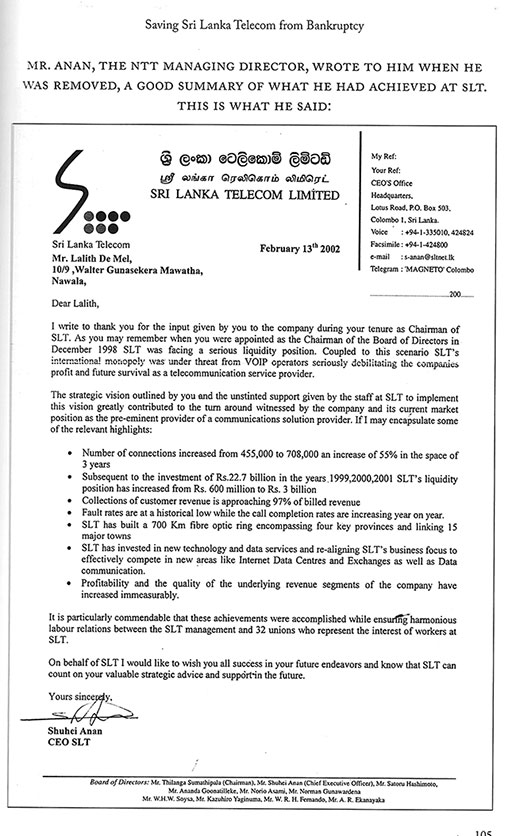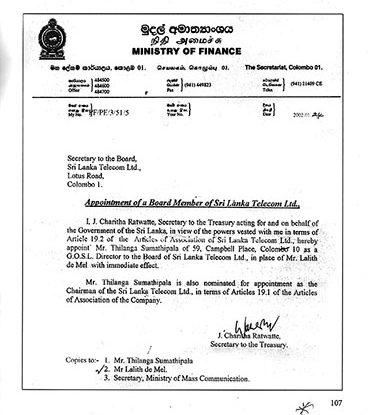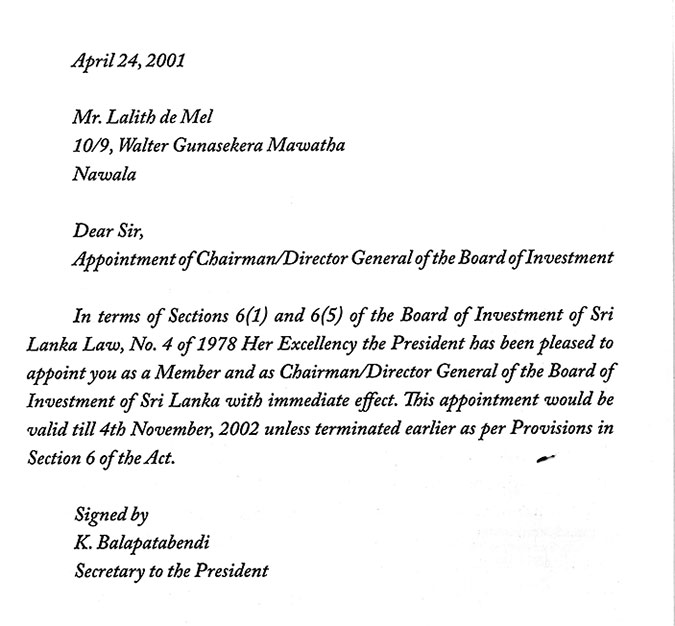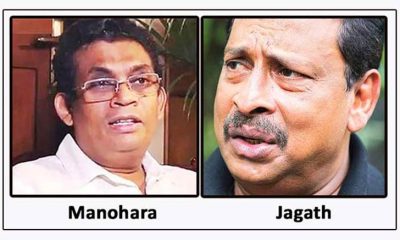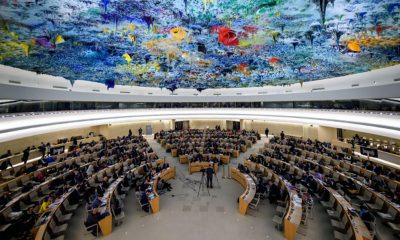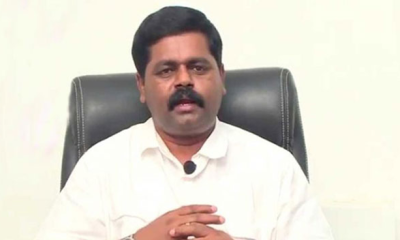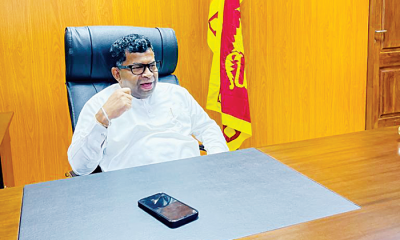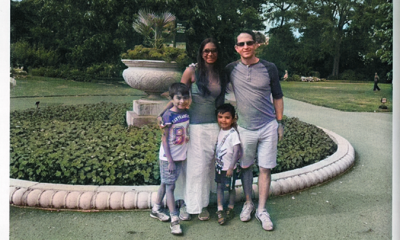Features
Rewarded for good job done at SLT by being fired, and musical chairs with Arjuna Mahendran
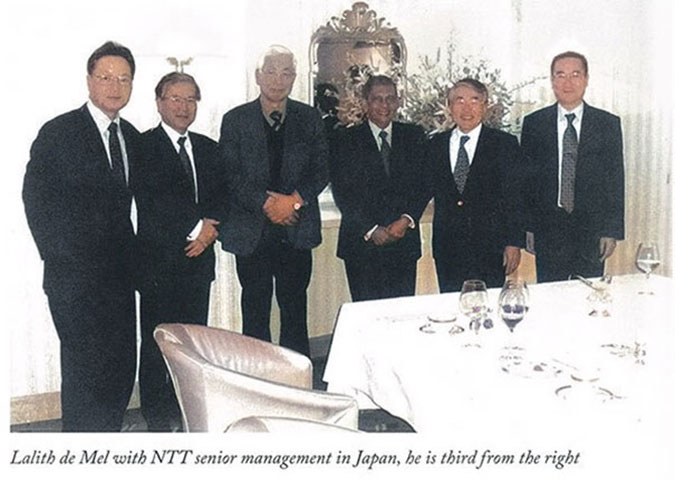
(Excerpted from the autobiography of Lalith de Mel)
Lalith de Mel has published facsimiles of two letter he had received from Shuhei Anan, the CEO of Sri Lanka Telecom, who was the nominee of NTT, the Japanese partner of the company, which he says is a “good summary” of what he had achieved at SLT and a second from Mr. J. Charitha Ratwatte, the new Secretary to the Treasury following the change of government which de Mel has acidly described as his reward for a job well done: getting fired.
These two letters are reproduced below:
Musical chairs with Arjuna Mahendran
“The President wanted me to take over as Chairman of the Board of Investment. This is an appointment that is made by the President. Thilan Wijesinghe had done well at the BOI. He had sustained a good image for it. It was seen as an important institution and being Chairman was a prestigious appointment. There was nothing radically wrong at the BOI and there was no need to take any urgent remedial measures.
It was a Government institution, and the staff were all Government servants, governed by the usual AR and FR regulations, and like all Government institutions, ran at its own pace. With the war with LTTE going on, it was difficult to entice foreign investment. It never came in a flood, and it was a hard task to keep a steady trickle of foreign investment coming in.
The biggest challenge was to live up to the expectations of current and new investors who viewed the BOI as a one-stop-shop that would meet all their needs. It had certain powers to approve foreign investment and ownership and grant tax holidays and work permits for foreign employees. That was the easy part of the BOI role. That was done promptly without delays.
What was difficult was to take investors rapidly through the obstacle course of getting approval the custodians of the various acts that had been designed to protect national assets. We have acts drafted by clever people to protect everything, environment, forests, antiquities, the coast, low-lying land, wildlife, coconut land, etc. Any new venture had to get a myriad approvals from people in no hurry to grant them and the only lubricant that expedited it was probably money.
There was anger and discontent that the BOI did not wave a wand and give them instant approval. Not even the President could do that, as the criteria for approval had to be met, and this was decided by the officials operating in slow-motion mode.
The concept of creating a one-stop-shop for foreign investment is still bandied around by politicians, but it can never be achieved until there is a radical revision of all acts to provide for mandatory approval within a specified time-frame if a number of boxes can be ticked by the applicant.
Published below is De Mel’s letter of appointment as Chairman/Director General of the Board of Investment:
Making room for Arjuna Mahendran
My role here also came to an end when Ranil Wickremesinghe became Prime Minister. He wanted to appoint Arjuna Mahendran as Chairman of BOI. Yes, the same now famous Arjuna Mahendran.
Arjuna Mahendran did not appreciate that his friend the Prime Minister could not make the appointment as it was an appointment that had to be made by the President. Before that had happened he stomped into my office at the BOI and rather pompously said: ‘I am the new Chairman of the BOI’
Second innings at the BOI
When the UNP lost the elections, CBK wanted me to return to the BOI for an important reason and I was duly appointed by her. It gave me some pleasure to walk into Arjuna Mahendran’s office at BOI and to tell him I was the new Chairman of BOI.
The SLFP had won the election in a coalition with the JVP, and the Cabinet had JVP ministers. My task was to convince the business community and importantly the foreign community that there would be no change in the economic philosophy of the Government and that it would remain committed to a free enterprise system.
Before accepting this task I insisted on meeting the JVP leaders to be sure that they accepted this position. I had meetings with Somawansa Amarasinghe, the Head of the JVP, Tilvin Silva and Wimal Weerawansa. The model that was developed and which they were prepared to accept was a private enterprise system that would not be expanded and where education, health, power, water, etc. that were in the State sector would continue to be in the State sector.
They remained faithful to what was agreed and during their tenure in Government never made demands for the State to take over any part of the private sector. I was relieved as what I had told the ambassadors and other foreign dignitaries was never contradicted.
My Minister was Anura Bandaranaike. He was a charming and intelligent person. He never came to the BOI office and I had to visit him periodically at his residence in Rosemead Place. It was then an interesting chat about books, plays and films and at the end he would ask whether everything was okay at BOI and I would reassure him that it was and leave him content that there was no cause for worry.
I had a meddling Board. They wanted me to remove some good people appointed during the previous UNP regime. I refused and did not do so, but it was tedious jousting with a Board pursuing their own agenda. I told the President that I had done the job for which I was appointed, namely to explain the JVP role in the Government. I also said that I could do something far more useful in my role as the Senior Advisor to the Ministry of Finance, and that I would therefore resign from my role as Chairman.
Making projects work, implementation of foreign aid-funded projects
“The major infrastructure projects were mostly funded by donors. Progress was slow and stuttering and the donors were not happy with progress. The Government was also concerned that key infrastructure projects were way behind schedule. The President was aware and concerned and it was her idea to set up a special unit to help to facilitate the implementation of projects. I was asked to head a new Project Implementation Unit. The Cabinet paper on the subject sets it all out clearly and is reproduced below.
Getting information
I was appalled to discover that there was no good information on progress and no monitoring unit. To monitor anything, information is essential and this was the key piece missing. That was my top priority. The software was developed quickly, the servers were obtained, we had a new monitoring system and we were up and running in no time.
We ran a quick course on project management for the Project Directors and also gave them very specific instructions on their role in the new system. The Project Directors were required to put on the system for each project a schedule of activity with start and end dates and funds required for each phase. Every month they had to report actual performance against the plan.
The Ministers and the President could see the progress or the lack of it on the computer screens in their offices. I scrapped the old system of getting all the Project Directors to come for a monthly review meetings. With over 100 projects, these meetings were a complete shambles. They went on endlessly trying to identify the generic problems that impeded implementation.
I replaced this macro approach of looking for magic solutions to problems with a hands-on micro approach of monitoring each individual project. The system was interactive, like email. The Project Directors could communicate problems and I could send my comments or seek assistance from some ministry and the project Director was in the loop as he saw this dialogue.
I had an office at the Planning Ministry with a team of young Administrative service officers. Each of them was responsible for monitoring a group of projects. My task was to solve the problems they could not solve by themselves. I was amazed at the progress we were able to make and have it all running smoothly by putting a few simple pieces in place.
Features
Kashmir terror attack underscores need for South Asian stability and amity

 The most urgent need for the South Asian region right now, in the wake of the cold-blooded killing by gunmen of nearly 30 local tourists in Indian-administered Kashmir two days back, is the initiation of measures that could ensure regional stability and peace. The state actors that matter most in this situation are India and Pakistan and it would be in the best interests of the region for both countries to stringently refrain from succumbing to knee-jerk reactions in the face of any perceived provocations arising from the bloodshed.
The most urgent need for the South Asian region right now, in the wake of the cold-blooded killing by gunmen of nearly 30 local tourists in Indian-administered Kashmir two days back, is the initiation of measures that could ensure regional stability and peace. The state actors that matter most in this situation are India and Pakistan and it would be in the best interests of the region for both countries to stringently refrain from succumbing to knee-jerk reactions in the face of any perceived provocations arising from the bloodshed.
The consequences for the countries concerned and the region could be grave if the terror incident leads to stepped-up friction and hostility between India and Pakistan. Some hardline elements in India, for instance, are on record in the international media as calling on the Indian state to initiate tough military action against Pakistan for the Kashmiri terror in question and a positive response to such urgings could even lead to a new India-Pakistan war.
Those wishing South Asia well are likely to advocate maximum restraint by both states and call for negotiations by them to avert any military stand-offs and conflicts that could prove counter-productive for all quarters concerned. This columnist lends his pen to such advocacy.
Right now in Sri Lanka, nationalistic elements in the country’s South in particular are splitting hairs over an MoU relating to security cooperation Sri Lanka has signed with India. Essentially, the main line of speculation among these sections is that Sri Lanka is coming under the suzerainty of India, so to speak, in the security sphere and would be under its dictates in the handling of its security interests. In the process, these nationalistic sections are giving fresh life to the deep-seated anti-India phobia among sections of the Sri Lankan public. The eventual result will be heightened, irrational hostility towards India among vulnerable, unenlightened Sri Lankans.
Nothing new will be said if the point is made that such irrational fears with respect to India are particularly marked among India’s smaller neighbouring states and their publics. Needless to say, collective fears of this kind only lead to perpetually strained relations between India and her neighbours, resulting in regional disunity, which, of course would not be in South Asia’s best interests.
SAARC is seen as ‘dead’ by some sections in South Asia and its present dysfunctional nature seems to give credence to this belief. Continued friction between India and Pakistan is seen as playing a major role in such inner paralysis and this is, no doubt, the main causative factor in SARRC’s current seeming ineffectiveness.
However, the widespread anti-India phobia referred to needs to be factored in as playing a role in SAARC’s lack of dynamism and ‘life’ as well. If democratic governments go some distance in exorcising such anti-Indianism from their people’s psyches, some progress could be made in restoring SAARC to ‘life’ and the latter could then play a constructive role in defusing India-Pakistan tensions.
It does not follow that if SAARC was ‘alive and well’, security related incidents of the kind that were witnessed in India-administered Kashmir recently would not occur. This is far from being the case, but if SAARC was fully operational, the states concerned would be in possession of the means and channels of resolving the issues that flow from such crises with greater amicability and mutual accommodation.
Accordingly, the South Asian Eight would be acting in their interests by seeking to restore SAARC back to ‘life’. An essential task in this process is the elimination of mutual fear and suspicion among the Eight and the states concerned need to do all that they could to eliminate any fixations and phobias that the countries have in relation to each other.
It does not follow from the foregoing that the SAARC Eight should not broad base their relations and pull back from fostering beneficial ties with extra-regional countries and groupings that have a bearing on their best interests. On the contrary, each SAARC country’s ties need to be wide-ranging and based on the principle that each such state would be a friend to all countries and an enemy of none as long as the latter are well-meaning.
The foregoing sharp focus on SAARC and its fortunes is necessitated by the consideration that the developmental issues in particular facing the region are best resolved by the region itself on the basis of its multiple material and intellectual resources. The grouping should not only be revived but a revisit should also be made to its past programs; particularly those which related to intra-regional conflict resolution. Thus, talking to each other under a new visionary commitment to SAARC collective wellbeing is crucially needed.
On the question of ties with India, it should be perceived by the latter’s smaller neighbours that there is no getting away from the need to foster increasingly closer relations with India, today a number one global power.
This should not amount to these smaller neighbours surrendering their rights and sovereignty to India. Far from it. On the contrary these smaller states should seek to craft mutually beneficial ties with India. It is a question of these small states following a truly Non-aligned foreign policy and using their best diplomatic and political skills to structure their ties with India in a way that would be mutually beneficial. It is up to these neighbours to cultivate the skills needed to meet these major challenges.
Going ahead, it will be in South Asia’s best interests to get SAARC back on its feet once again. If this aim is pursued with visionary zeal and if SAARC amity is sealed once and for all intra-regional friction and enmities could be put to rest. What smaller states should avoid scrupulously is the pitting of extra-regional powers against India and Pakistan in their squabbles with either of the latter. This practice has been pivotal in bringing strife and contention into South Asia and in dividing the region against itself.
Accordingly, the principal challenge facing South Asia is to be imbued once again with the SAARC spirit. The latter spirit’s healing powers need to be made real and enduring. Thus will we have a region truly united in brotherhood and peace.
Features
International schools …in action

 The British School in Colombo celebrated the 2025 Sinhala and Tamil New Year with the traditional rites and rituals and customs unique to the island nation, during a special Avurudu Assembly held at the school premises.
The British School in Colombo celebrated the 2025 Sinhala and Tamil New Year with the traditional rites and rituals and customs unique to the island nation, during a special Avurudu Assembly held at the school premises.
Students from all over the world, who are part of The British School in Colombo, gathered to celebrate this joyous event.
The special assembly featured traditional song and dance items from talented performers of both the Junior and Senior Schools.
On this particular day, the teachers and students were invited to attend school in Sri Lankan national costume and, among the traditional rituals celebrated, was the boiling of the milk and the tradition of Ganu-Denu.

Boiling of
the milk
In the meanwhile, a group of swimmers from Lyceum International School, Wattala, visited Australia to participate in the Global-ISE International Swimming Training Programme in Melbourne.
Over the course of 10 days, the swimmers followed an advanced training schedule and attended sessions at the Melbourne Sports and Aquatic Centre (MSAC), Victoria’s Nunawading Swimming Club, and Camberwell Grammar School.
In addition to their training, the group also explored Melbourne, with visits to key landmarks, such as the Parliament House and the Melbourne Cricket Ground (MCG), along with city tours and cultural experiences.

Traditional dance item

Tug-of-war contest

On arrival in Melbourne, Lyceum International School, Wattala, with Sri Lankan officials
Features
Perfect … and healthy

 Got a few more beauty tips to give you … for a perfect complexion, or, let’s say, a healthy skin.
Got a few more beauty tips to give you … for a perfect complexion, or, let’s say, a healthy skin.
* Honey Face Mask:
Take a tablespoon of raw honey and then warm it up by rubbing it with your fingertips. Apply the warm honey all over your face. Let this natural mask stand for about 10 minutes and then wash it off gently with warm water.
* Coconut Milk Face Mask:
You need to squeeze coconut milk out of a grated raw coconut and apply this milk all over your face, including your lips.
(This will help you gain a glowing skin. It is one of the best natural tips for skin care)
* Orange, Lemon, and Yoghurt Moisturiser:
To prepare this moisturiser, you need a tablespoon of orange juice, a tablespoon of lemon juice and a cup of plain yoghurt.
Mix them together and apply the paste all over your face, leaving it as a mask for 10 to 15 minutes. Next, take a damp handkerchief and use it to clean your face.
(This moisturiser brightens the complexion of your skin)
* Cucumber and Lemon:
Apply equal parts of cucumber and lemon juice on your face before taking a bath. Allow it to sit for 10 minutes before rinsing it off. This natural face beauty tip will brighten your skin tone and lighten blemishes if used on a regular basis. The best aspect is that it is appropriate for all skin types!
* Healthy Diet:
Aside from the effective home remedies, there are certain other factors to consider for skin care – and the first of them is your diet. Without the right nutrients, your skin cannot reverse the damage it suffers every day.
Eat fruits that are high in vitamin C because they contain antioxidants.
Adjust your diet to get the right amount of protein and unsaturated fats, as well as fresh green vegetables. All of this provides the right amount of nutrients so your skin can heal and improve itself naturally.
* Sun Protection and Care:
Another thing to keep in mind is not to step out of your home without sunscreen, especially with this awful heat we are experiencing at the moment. The hard rays of the sun can do you more damage than you could ever imagine.
By the way, you can prepare your own sunscreen lotion with glycerin, cucumber juice and rose water. You can also keep this lotion in the fridge.
-

 Business5 days ago
Business5 days agoDIMO pioneers major fleet expansion with Tata SIGNA Prime Movers for ILM
-

 News4 days ago
News4 days agoFamily discovers rare species thought to be extinct for over a century in home garden
-

 Features6 days ago
Features6 days agoProf. Lal Tennekoon: An illustrious but utterly unpretentious and much -loved academic
-

 Foreign News5 days ago
Foreign News5 days agoChina races robots against humans in Beijing half marathon
-

 Features2 days ago
Features2 days agoRuGoesWild: Taking science into the wild — and into the hearts of Sri Lankans
-

 Editorial5 days ago
Editorial5 days agoSelective use of PTA
-

 News2 days ago
News2 days agoOrders under the provisions of the Prevention of Corruptions Act No. 9 of 2023 for concurrence of parliament
-

 Features4 days ago
Features4 days agoThe ironies of history


